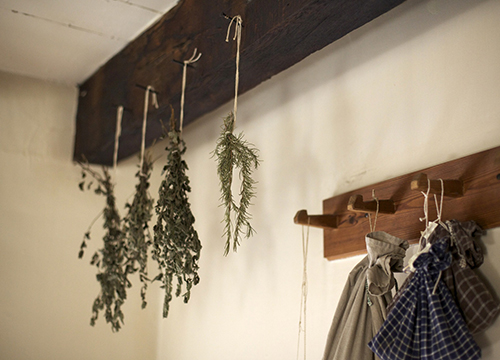Herbs - Harvesting, Drying, Storing, & Freezing


Drying
Most herbs can be used fresh or dried, except Sweet Woodruff, which has to be dried before use, as it has no smell when fresh. Small amounts of leafy herbs can be dried in an airy room-preferably in the dark, but definitely in the absence of sunlight. The humidity must be low. Tied in small bunches and hung upside down, most of them will dry in about two weeks in warm summer weather. The exception to this is curly parsley, which needs some artificial heat to dry quickly enough to retain its flavor and good color. Bouquets of herbs can be hung in a dry airy place like an attic, upside down. Tie a paper bag over the bouquet to keep it from the light and to catch falling herbs. Allow two weeks to dry, but check its progress daily.
Quick Drying
The slow oven method is excellent for quick-drying small quantities of leafy herbs. It will not damage flavor or color if temperature is held between 75 and 77 degrees F. Hotter than the maximum will dry out oils and damage the flavor and color. Cooler will slow up the drying process, and could cause condensation, which might result in an off-flavor, caused by mold. Some artificial heat is usually needed to dry the roots of herbs. Use the oven method for home drying. Large roots should be sliced about 1/4” thick. They will take from three to five weeks (possibly more) to dry, depending on their condition and drying temperatures. To be ready to store, they must break with a snap when bent over. Store them in airtight containers.
Microwave Drying
Start with a clear, sunny day, because in humid weather herbs may re-absorb moisture when removed from the microwave. Brush soil from leaves and stems with a stiff paintbrush. Place about a cup of herbs in a single layer between paper towels; microwave on high for about three minutes (delicate herbs like thyme should be turned every 30 seconds). If herbs aren’t completely dry in three minutes, reset timer for 20 seconds; start again. Don’t let the herbs get too hot or they’ll taste scorched. They’re ready when they feel brittle and rattle when you shake the paper towels, or when the leaves pull easily from the stem.
In The Refrigerator
Herbs like parsley, coriander leaf, and rosemary dry well in the refrigerator. Place an unwashed bouquet in a paper bag (not a plastic bag). Close the bag and leave there for about a month. It will be green, dry, and aromatic.
Tips for Freezing
Tough stemmed herbs like basil, tarragon, and sage should have their leaves removed for freezing. Brush off the soil with a stiff paintbrush rather than washing because too much water may dilute flavors. Lay them on a flat cookie sheet and freeze for several hours. Then, place them gently into freezer containers or bags, and they’ll be easy to remove individually as needed. If blanched, color will usually stay greener, but flavor and aroma will often be sacrificed. Basil is an exception; it should be blanched, or it will turn black. Most other herbs will freeze well unblanched for up to 6 months if it is done just after harvesting. After that, they begin to deteriorate.
To blanch, place leaves in a strainer and pour boiling water over them for one second. Lay them on paper towels and let cool in the air before freezing. Don’t be tempted to cool the leaves by plunging them into ice water, because it could dilute the flavor. Delicate herbs like thyme and dill freeze well in sprigs. Arrange them in freezer containers or bags and seal. Use whole frozen sprigs or snip them as needed. If you need to grind your dried herbs ahead of time, freezing will preserve their flavors longer than keeping them at room temperature.
Using
Many frozen herbs can be used as you would fresh—about 2 teaspoons to serve four people. Take the herbs from the freezer and toss them (without defrosting) into soups, stews, and sauces. If using them in salads or other uncooked foods, drain first. Flavors can change during freezing, so taste, and, if necessary, adjust before serving.
Storing
Glass bottles are best, one advantage being that during the first few weeks, it is easy to see if any moisture appears, indicating inadequate drying. If this happens, herbs must be redried. Keep in a dark cupboard, unless you are able to get dark-colored bottles. You may also store them in plastic bags or tins. Whatever the containers used, they must be absolutely airtight. Be sure they are clean and dry before herbs are put in. If they are away from light and heat, they’ll be flavorful for about a year. Don’t make the mistake of storing dried herbs above or next to the stove, for the heat will dissipate the flavors.
Harvesting Tips
Use sharp cutting tools. Never pull or break off branches or stems. Care is especially essential for the perennial herbs. Don’t pile up fresh-cut herbs, or put them in a sack for they’ll heat up and get crushed, causing loss of volatile oils. Put in shallow boxes, and if you have hosed them off the day before to wash, you will not have the time-consuming job of washing all the little pieces. Start drying at once. Leaves do not have to be stripped off the stems before drying them. They get bruised when handled-resulting in loss of essential oils. If flowers are to be harvested, they should be fully open when picked for drying. When roots of herbs are needed, dig as soon as the leaves have begun to die down, usually in late fall. Be careful not to damage roots when digging. Clean with a hose gun, but don’t brush, for the bristles may damage them.
